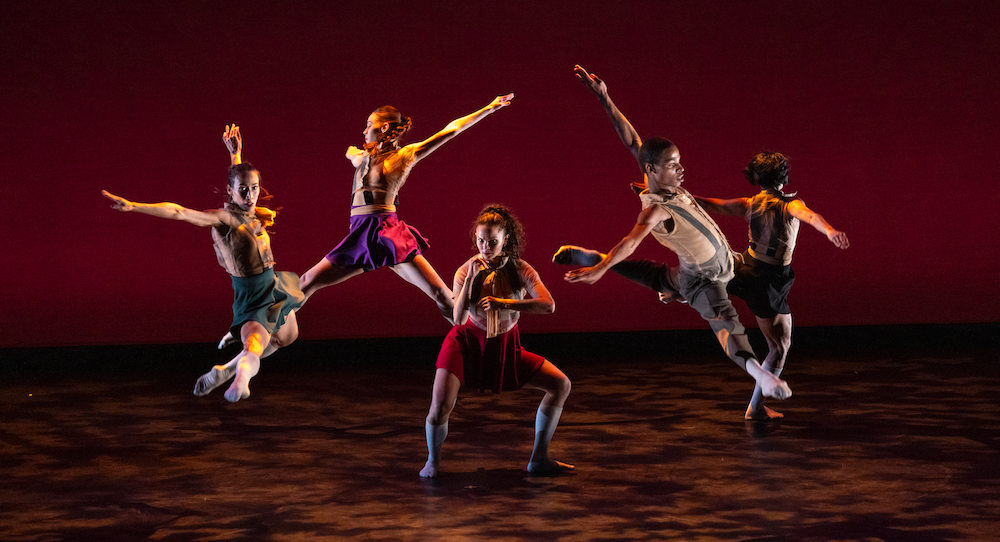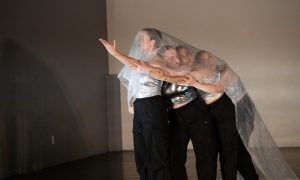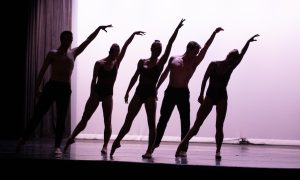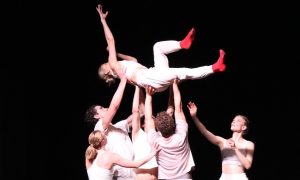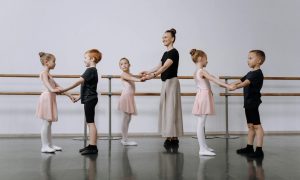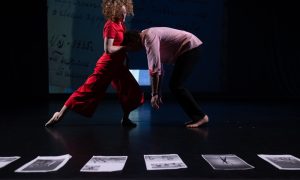The Emerson Paramount Center, Boston, MA.
January 18, 2025.
Cuba: a nation that many know as holding a culture vibrant and resilient, yet also stuck in decades past (due to economic and political embargos). With some of those obstacles softened in recent years, cultural exchange such as Malpaso Dance Company (Havana, Cuba) touring northeast cities has blossomed. I was grateful to catch the company in Boston, through the city’s Celebrity Series. It’s the second time the series has hosted the company, the first in 2016.
Rather than any kind of stasis or anything outdated, I saw exciting eruptions of movement innovation. At the same time, the work felt rooted in the gifts of Cuban culture: its ebullient music, movement and plain zest for being alive. On offer was an elegant shaping of long-standing culture – as well as various other tools and stylings of contemporary dance – into something bold, experimental and fully capable of captivating.
Ephrat Asherie’s Floor…y Ando (2023, danced by Esteban Aguilar, Osnel Delgado and Esven González) opened the program. For a trio, and a work on the shorter side, it’s one bursting with layered richness. The ensemble beautifully rode the spatial tension inherent in the frequent converging and diverging in Asherie’s staging. Their inhabiting of rise and fall through space, expanding and then connecting back into personal kinesphere, felt just as clear. Especially as a program opener, it was a wonderful reminder that in this art form – and in anything, really – the excitement can rest at the intersections of opposites.
Ronald K. Brown’s highly satisfying, soothing yet vivacious Why You Follow (2014) came second in the program. It began with private indulgence in sweet groove, a personal communion with the score (Zap Mama’s “Look at Africa”). More dancers accrued, and that private indulgence became communal. The ensemble was beautifully attuned to both that personal pleasure and group cohesion. Tools such as call-and-response, accumulation and canon gave them the fodder for such an effect.
They “followed” one another’s pleasure in blissful movement. Base vocabulary – shimmying shoulders, feet toe-heeling, quick and low kicks to the side, lunged legs – became more expansive and athletic, but the ease found in that movement indulgence remained: through myriad sections, groupings and a shift of atmosphere to red lighting (building more of a “club” feel, lighting design by Clifton Taylor).
A motif of both pointer fingers raised, elbows bent, almost seemed to call for attention to the moving moment: to not lose it to mental chatter, the detritus of everyday life hassles and what we absorb while “doomscrolling.” That’s a reminder we could increasingly use these days, this humble writer believes.
Like in a party, groups shifted. Action simmered and erupted in turn. Part of me wanted slower tempos, more rhythmic variance – which would allow dancers to savor all of the beautiful complexities and nuances in the vocabulary. Yet, the consistent quick speed did build an attunement with the score of pure vitality and joy, that which enhanced the cohesion at hand.
It was a connection that nurtured euphoria, in and amongst the bodies commanding the stage. I, as a movement lover, as is common for me, wanted to jump up and “follow” them as well. Perhaps those less apt to spontaneously move their bodies could vicariously absorb some of that pure kinetic bliss as well, maybe even feel a bit inspired to find that for themselves. With such joy and ease behind the proscenium, that would only be natural.
Closing the program was Osnel Delgado’s A Dancing Island (2023) — somewhat reflective and cerebral, yet with just and much pure joy and energy to share. Like Why You Follow, it began in a place of solitude, with ensemble members independently moving through varied movement vocabulary. Yet, kinetic and communal connection returned to the stage before long. Perhaps that’s just what cooks up from the recipe of bodies moving together in space with music.
Dancers circled their arms overhead, hands clasped, finding something expansive yet connected to their own space. Feet took a compass path as dancers turned, their bodies grounding yet also searching. Popped hips and waving scarves helped to build something flirty and playful as the energy built into new sections. Teasing and enticing with those ingredients, the women were fully in their power.
Little theatrical moments painting those dynamics even offered a few laughs (from myself and, I could hear, fellow audience members). Sassy tenacity grew as the score got faster and more layered. Music – that in Cuba’s cultural tapestry, its aural history, as the program described – guided these fresh and memorable terpsichorean offerings.
I did crave a bit more of an internal structural logic; at times energy immediately accelerated from 0 to 60, or vice versa, as sections shifted. Perhaps that only resulted from following an actual history – which can certainly feel messy and unpredictable. The variety of rhythm and energetic calibration did at least offer that which I had wanted in the prior piece.
One particularly poignant duet, with both dancers beautifully sinewy and technically strong as can be – presented this softer, more intimate atmosphere. He joined her from the audience, adding a realism and honesty to their connection; it could have been him coming to her from anywhere, on any day. Before that, she looked out into the audience as the house lights rose: intentionally or not, shifting through gaze on us, asking if we may find the same connection with movement, music and one andother.
To end, the dancers continued moving in unison, but music faded down. We heard only white noise. The absence of music’s magic certainly felt stark to me. Life hums on underneath the soundtracks to our lives – the soundtracks nevertheless making them a whole lot more vibrant, connected and plain fun.
As we in the audience ripple-rose for a standing ovation, I thought about the power of the cultural exchange that just happened – and grateful that it could happen. Spanish, English or any other language spoken, guided by whatever cultural norms or mores, we could join together in celebration of music and movement. A woman behind me exclaimed, several times, “viva Cuba!” Indeed!
By Kathryn Boland of Dance Informa.


